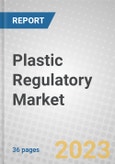Although banning plastic bags is becoming more popular as a policy solution to reduce plastic bag litter, opinions on its justification and efficacy are divided. This study examines the advantages, drawbacks, and unforeseen effects of banning plastic bags. The report identifies countries that have regulations on plastics.
The current report provides detailed exposure to regulatory requirements for plastics manufacture, import, stocking, distribution, and sale. Furthermore, the report also mentions countries where there are limits on thickness of plastic carrier bags.
Report Includes
- A brief general outlook of the global markets for plastics regulations
- Understanding of plastics regulatory and the status of plastic bag policies in North America, Europe, Asia-Pacific, Africa, South America, Central America, and the Caribbean
- Review of the impact of plastic bag bans and instruments most frequently used to address plastic pollution
- Recommendation of actions that could potentially cut down on single-use plastics debris by half








